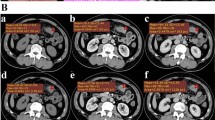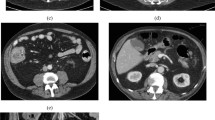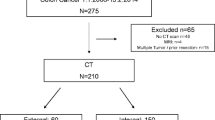Abstract
Objective
By evaluating extent of tumour enhancement on preoperative contrast-enhanced MDCT, we aimed to establish an imaging-based model to predict cancer-specific survival in stage I–III colon cancer.
Methods
A total of 548 stage I–III colon cancer patients who underwent curative resection from 2007 to 2013 were retrospectively included and divided into primary cohort and validation cohort according to admission time. The attenuation coefficient of each colon cancer was measured on the workstation by drawing the ROI in CT images. The enhancement ratio was calculated using maximum tumour attenuation value in triphasic MDCT scanning divided by the minimum. Patients were divided into low/high-enhancement groups according to the optimal cut-off value derived from time-dependent ROC curve. Kaplan–Meier method and COX regression analysis were adopted to evaluate prognostic value of variables. A nomogram for prognosis was conducted on the basis of a multivariate Cox proportional hazard model.
Results
No significant differences were observed in age, sex, pTNM stage, perioperative chemoradiotherapy, serum CEA, tumour size, tumour localisation and histologic type between low- and high-enhancement groups. The high-enhancement group had a significantly shorter cancer-specific survival rate (69.5%) than the low-enhancement group (85.9%) (p < 0.001). Subgroup analysis indicated that high-enhancement state was closely associated with increased risk of colon cancer mortality in stage I (p = 0.033), stage II (p = 0.002) and stage III (p = 0.014). Cox regression analysis indicated the extent of enhancement was an independent prognostic factor (HR 2.258, 95% CI 1.476–3.455; p < 0.001).
Conclusions
The extent of tumour enhancement on MDCT can serve as a potential risk factor for stage I–III colon cancer.
Key Points
• Survival rates of stage I–III colon cancer vary widely even within the same stage.
• Prognostic value of the extent of tumour enhancement on MDCT was assessed.
• The high-enhancement group had a significantly shorter cancer-specific survival rate.





Similar content being viewed by others
Abbreviations
- CRC:
-
Colorectal cancer
- MDCT:
-
Multidetector-row computed tomography
References
Siegel RL, Miller KD, Jemal A (2016) Cancer statistics, 2016. CA Cancer J Clin 66:7–30
Chen W, Zheng R, Baade PD et al (2016) Cancer statistics in China, 2015. CA Cancer J Clin 66:115–132
André T, Boni C, Mounedji-Boudiaf L et al (2004) Oxaliplatin, fluorouracil, and leucovorin as adjuvant treatment for colon cancer. N Engl J Med 350:2343–2351
Mols F, Beijers T, Lemmens V, van den Hurk CJ, Vreugdenhil G, van de Poll-Franse LV (2013) Chemotherapy-induced neuropathy and its association with quality of life among 2- to 11-year colorectal cancer survivors: results from the population-based PROFILES registry. J Clin Oncol 31:2699-2707
Sobrero A, Grothey A, Iveson T et al (2018) The hard road to data interpretation: three or six months of adjuvant chemotherapy for patients with stage III colon cancer? Ann Oncol https://doi.org/10.1093/annonc/mdy064
Gill S, Loprinzi CL, Sargent DJ et al (2004) Pooled analysis of fluorouracil-based adjuvant therapy for stage II and III colon cancer: who benefits and by how much? J Clin Oncol 22:1797–1806
Benson AB 3rd, Hamilton SR (2011) Path toward prognostication and prediction: an evolving matrix. J Clin Oncol 29:4599–4601
Greene FL, Page DL, Flemming ID, Fritz AG, Balch CM (eds) (2010) AJCC cancer staging manual, 7th edn. Springer, New York
Ginat DT, Gupta R (2014) Advances in computed tomography imaging technology. Annu Rev Biomed Eng 16:431–453
Naqvi J, Hosmane S, Lapsia S (2015) Revisiting the potential signs of colorectal cancer on contrast-enhanced computed tomography without bowel preparation. Abdom Imaging 40:2993–3001
Miles KA (1999) Tumour angiogenesis and its relation to contrast enhancement on computed tomography: a review. Eur J Radiol 30:198–205
Salvaggio G, Furlan A, Agnello F et al (2014) Hepatocellular carcinoma enhancement on contrast-enhanced CT and MR imaging: response assessment after treatment with sorafenib: preliminary results. Radiol Med 119:215–221
Choi H, Charnsangavej C, Faria SC et al (2007) Correlation of computed tomography and positron emission tomography in patients with metastatic gastrointestinal stromal tumor treated at a single institution with imatinib mesylate: proposal of new computed tomography response criteria. J Clin Oncol 25:1753–1759
Wang SH, Sun YF, Liu Y, Zhou Y, Liu Y (2015) CT contrast enhancement correlates with pathological grade and microvessel density of pancreatic cancer tissues. Int J Clin Exp Pathol 8:5443–5449
Komori M, Asayama Y, Fujita N et al (2013) Extent of arterial tumor enhancement measured with preoperative MDCT gastrography is a prognostic factor in advanced gastric cancer after curative resection. AJR Am J Roentgenol 201:W253–W261
Zhu YH, Wang X, Zhang J, Chen YH, Kong W, Huang YR (2014) Low enhancement on multiphase contrast-enhanced CT images: an independent predictor of the presence of high tumor grade of clear cell renal cell carcinoma. AJR Am J Roentgenol 203:W295–W300
Altman DG, Royston P (2000) What do we mean by validating a prognostic model? Stat Med 19:453–473
Folkman J (1971) Tumor angiogenesis: therapeutic implications. N Engl J Med 285:1182–1186
Goh V, Halligan S, Wellsted DM, Bartram CI (2009) Can perfusion CT assessment of primary colorectal adenocarcinoma blood flow at staging predict for subsequent metastatic disease? A pilot study. Eur Radiol 19:79–89
National Comprehensive Cancer Network (2018) NCCN clinical practice guidelines in oncology, V.1.2018. https://www.nccn.org/professionals/physician_gls/default.aspx
Bertagnolli MM, Redston M, Compton CC et al (2011) Microsatellite instability and loss of heterozygosity at chromosomal location 18q: prospective evaluation of biomarkers for stages II and III colon cancer–a study of CALGB 9581 and 89803. J Clin Oncol 29:3153–3162
Hutchins G, Southward K, Handley K et al (2011) Value of mismatch repair, KRAS, and BRAF mutations in predicting recurrence and benefits from chemotherapy in colorectal cancer. J Clin Oncol 29:1261–1270
Guinney J, Dienstmann R, Wang X et al (2015) The consensus molecular subtypes of colorectal cancer. Nat Med 21:1350–1356
Acknowledgements
We thank Dr. Ying Chen from the Department of Radiology for analysing CT images, Dr. Yue Liu from the Cancer Institute for collecting colon cancer tissues in the tissue bank and Dr. Zexin Chen from the Center of Clinical Epidemiology and Biostatistics for statistical analysis.
Funding
This work was supported by grants from the National Key R&D Program of China (2017YFC0908200) to KF Ding, Educational Department of Zhejiang Province of China (Y201738820 to ZH Wang) and National Natural Science Foundation of China (No. 81472664 to KF Ding; No. 81472819 to LF Sun; No. 81773181 to Dong Xu). The sponsors of the study had no role in study design, data collection, data analysis, results interpretation, writing the paper and the decision to submit the paper for publication.
Author information
Authors and Affiliations
Corresponding authors
Ethics declarations
Guarantor
The scientific guarantor of this publication is Prof. Kefeng Ding.
Conflict of interest
The authors of this manuscript declare no relationships with any companies whose products or services may be related to the subject matter of the article.
Statistics and biometry
Dr. Zexing Chen kindly provided statistical advice for this manuscript.
Informed consent
Written informed consent was obtained from all subjects (patients) in this study.
Ethical approval
Institutional review board approval was obtained.
Methodology
• retrospective
• observational
• performed at one institution
Electronic supplementary material
ESM 1
(DOCX 290 kb)
Rights and permissions
About this article
Cite this article
Wang, Z., Ye, Y., Hu, Y. et al. Extent of enhancement on multiphase contrast-enhanced CT images is a potential prognostic factor of stage I–III colon cancer. Eur Radiol 29, 1114–1123 (2019). https://doi.org/10.1007/s00330-018-5689-3
Received:
Revised:
Accepted:
Published:
Issue Date:
DOI: https://doi.org/10.1007/s00330-018-5689-3




